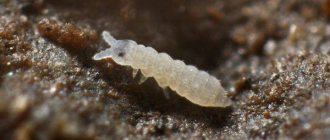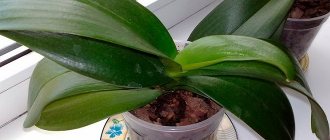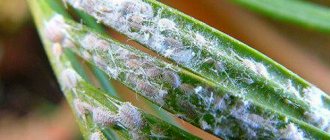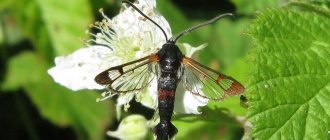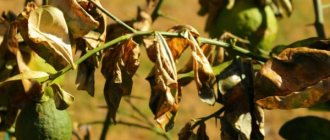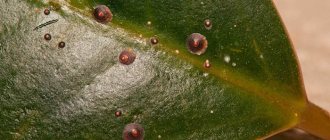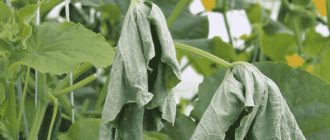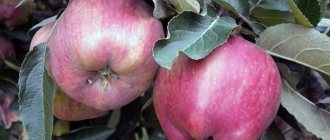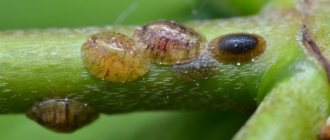The mealybug or feltworm is a sucking pest that affects many types of plants. This is the common name for insects from the order Coccidae, the closest relatives of garden scale insects.
Pests can be found in the garden on fruit and stone fruit trees, in greenhouses, film shelters, in greenhouses and in apartments on indoor plants.
Mealybug or hairy louse affects:
- roots of domestic citrus and violets;
- foliage of dracaena - the plates become sticky and fall off;
- on the orchid - buds, blossoming leaves;
- money tree - they braid the trunk with white fluff.
Monstera, fuchsia, croton, camellia, anthurium, and many other types of domestic plants become habitats and breeding grounds for scale insects. Flowers are inhibited, the process of photosynthesis is disrupted.
Description
In nature, there are about 1,600 species of mealybugs. These pests affect fruit, greenhouse, industrial and ornamental plant crops, and do not leave the flora until they turn it into a dried herbarium.
Some species are distinguished by the fact that they release useful substances that are used in the paint and varnish industry. Thus, varnish bug and cochineal produce red carmine dye.
In size and lifestyle, scale insects are similar to aphids, but are slightly different in appearance. Due to the accumulation of these tiny white insects, the flower looks as if it is dusted with flour - hence the name of the pest. Also, on plants affected by mealybugs, you can find sugary secretions - the so-called Honeydew, and a sooty fungus that settles on the secretions of mealybugs. These are side problems caused by a harmful pest.
The mealybug is a sucking pest and can easily be seen on plants with the naked eye. This insect has an oval-shaped body ranging from 3 to 6 mm in length, depending on the variety. It has many legs and long antennae. The whole thing is covered with a white waxy powdery coating with bristles on the sides. People also call this insect a hairy louse.
Larvae and mature individuals of the insect feed on the sap of young shoots of the plant, the sap of its leaves and buds. They produce white sticky mucus, which interferes with gas exchange in the plant. In addition, at the site of the bite, harmful insect enzymes enter the plant, disrupting its development. The affected plant is suppressed and stops growing. These insects are quite mobile and move from plant to plant without problems. Females and their offspring live directly on the affected plants. In some species of mealybugs, females are viviparous, but most females lay their eggs in a white facial sac that looks like a piece of cotton wool. Their fertility is very high - from 2 to 6 generations per year in different species.
The first instar larvae are called wanderers, as they actively move around the plant and can even be transferred to other plants by a draft or with the help of an animal or person. But when the larva attaches itself to the plant, it loses its mobility. The larvae of the next instar after molting again look for a place to feed. Males have small wings and limbs and may live nearby. As adults, males do not feed because they lack mouthparts. These individuals settle in flower containers, in the soil and even on window sills.
This may be interesting: Whitefly on indoor plants - how to deal with the pest?
Folk remedies
If berry crops are slightly affected by mealybugs, then to get rid of the pest it is recommended to use folk remedies that are less toxic than pesticides. For example:
- Oil . A couple of liters of water are mixed with 2 tbsp. l. olive oil. The resulting product is applied to the bushes using a spray bottle.
- Horsetail tincture . This drug can be purchased at a pharmacy and is used to purify the blood and as a diuretic. To treat the bush, use a cotton swab, which is moistened in the tincture.
- Soap solution with alcohol . 10 milligrams of denatured alcohol and 1 gram of liquid soap are dissolved in one liter of water.
- Garlic infusion . Half a liter of boiling water is combined with four or five garlic cloves, which are pre-chopped. The infusion will be ready after 4–5 hours; it is only filtered and processing begins immediately after that.
- Garlic tincture . Seventy percent alcohol is combined with chopped garlic in a 3:1 ratio. The treatment is carried out using a cotton swab.
- Citrus infusion . Add 50 grams of citrus peels (tangerine, orange or lemon) to 1 liter of warm water. The infusion will be ready after 24 hours; immediately after it has been filtered, begin spraying the bushes.
- Calendula infusion . One liter of water is combined with 100 grams of dried calendula flowers. After 24 hours, the infusion is filtered, and then it is used to wipe the affected areas.
- Hot water . First, the bush affected by scale insects is pulled out of the container, then its root system should be cleaned of the substrate, which may contain pests. Then the entire bush is immersed in warm water (from 45 to 55 degrees) for a quarter of an hour. Next, the plant is thoroughly dried and planted in a new disinfected soil mixture.
But remember that folk remedies will be effective only if there are very few pests, either at the initial stage of infection, or for preventive purposes. If there are already a lot of pests on the plant, then the bush should be immediately treated with a systemic insecticidal preparation, since folk remedies will be ineffective and by using them, you can lose precious time.
Mealybug! How did I get rid of him!!! Salicylic acid.
Kinds
For indoor plants, the following types of mealybugs are considered the most dangerous: bristly, seaside, grape and citrus.
Bristle mealybug (Pseudococcus longispinus)
Bristle Mealybug
Only the larvae and females of this parasite harm the plant. The body of an adult female has an elongated oval shape, 3.5 mm in length, pink or orange, covered with a white powdery coating. Females of this species are viviparous. They are collected in the form of colonies on the undersides of leaves, in the axils and on young shoots. The legs of scale insects are well developed; they easily move from one plant to another. Damaged leaves turn yellow and fall off. The shoots stop growing. In citrus fruits they get under the bark, in bulbous fruits they get under the scales of the bulbs. Plants damaged by scale insects are stunted in growth, severely depressed and may die.
Grape mealybug (Pseudococcus cifri)
Grape mealybug
It differs in that the female’s body has a wide oval shape, yellowish or pink, and is also covered with a white powdery coating. Males are rare in this species. The larvae settle throughout the plant, attaching themselves to leaves and shoots along the main veins. They form huge colonies. Plants lose all their juices, leaves fall off, shoots dry out, and the plant dies.
Seaside mealybug (Pseudococcus affinis)
Primorye mealybug
This is one of the most common types of scale insects. An adult female has an elongated, oval-shaped body, up to 4 mm in length and up to 2.5 mm in width. It is grayish-pink in color, like other scale insects and covered with a white powdery coating. Males are much smaller in size, but they have wings and fly all summer. Females lay eggs in so-called egg sacs - a fluffy white mass that is hidden in secluded places - in curled leaves, in cracks in the bark, in the forks of branches. The larvae are very mobile, without a waxy coating, and yellow in color. In some place they attach, stick and become motionless. After a month, the larva turns into an adult insect. Hordes of these insects suck out all the juices from the plant, the leaves turn yellow and fall off, the plant stops developing and dies.
How to recognize
Mealybug infestation of indoor plants is determined by the following signs:
- On the surface of the leaves you can see an incomprehensible nectar in the form of drops.
- On the stems, buds and leaves, as well as in the root zone, colonies of this pest are visible, similar to cotton wool with white cobwebs. There can be many such colonies. The more affected areas, the more difficult it is to cope with this pest.
- The stem begins to deform, and the growth of the flower is inhibited. At the same time, its appearance deteriorates.
- The leaves curl, turn yellow and begin to fall off as they lack nutrients.
- The action of the mealybug promotes root rot.
- If you do not fight this parasite in time, there is a risk of plant death.
- The life activity of the mealybug is distinguished by one feature: if there are no favorable conditions, then this parasite can remain in an inert state for a long time, that is, in a state of suspended animation. When the temperature and humidity reach the optimal level, the mealybug immediately begins active life, sucking the juices from the plant and continuing to reproduce.
Plants at risk
The most commonly attacked by mealybugs are azaleas, amaryllis, asparagus, anthurium, grapes, gerbera, hibiscus, dracaena, cacti, Kalanchoe, camellia, croton, monstera, oleander, palm trees, pachystachys, fuchsia and philodendron. It is quite simple to understand that your plant has a parasite. For example, we can tell about the presence of mealybugs on dracaena by the sticky leaves that begin to noticeably turn yellow and fall off. On orchids, buds, flowers and young shoots begin to deform from these insects. We urgently need to take action - such orchids need to be cut and burned urgently! If a mealybug infects a money tree, it will look like a Christmas tree because fluffy white lumps appear in the axils of the leaves and on the green branches - traces of the parasite's vital activity. In violets, as well as in citrus fruits, mealybugs attack the root system. If the flower were planted in a transparent pot, the moldy roots of the diseased plant would be clearly visible.
This may be interesting: How to get rid of aphids on indoor plants
Why are mealybugs dangerous?
The mealybug (both the imago and the larva) feeds on plant sap, thereby having a negative effect on it:
- slows growth;
- worsens appearance;
- reduces fertility and quality of fruits;
- The waste of the mealybug becomes the cause of sooty fungus.
Let's clarify the last point a little. During its life, the mealybug secretes honeydew or honeydew, which is a sticky, sweet liquid. It creates favorable conditions for the development of fungal diseases, sooty fungus is the most popular of them.
The danger of mealybugs lies in the fact that the pest injures all organs of the plant (root system, above-ground parts), in addition, it easily moves from one bush to another.
Large colonies can completely destroy plantings. It should be borne in mind that mealybugs can settle on almost any plant. Most often, arthropods infect grapes, cactus, lemon, anthurium, azalea, fuchsia, palm, camellia, cissus, oleander, hibiscus, orange, amaryllis, gerbera, monstera, asparagus, Kalanchoe, philodendron.
This insect easily adapts to its living conditions. In addition, it has high fertility. Considering that the female lives only 3-6 months, she manages to bear offspring at least 3 times. The size and immobility of the mealyworm make it invisible in the absence of a large colony.
Despite this unusual method of movement, the pest often enters the house, causing the death of indoor plants. Infection usually occurs due to the purchase of a new plant. In gardens and orchards, the cause of the appearance of a colony is most often the presence of a group of pests in untreated areas.
This insect does not pose a threat to humans or animals. However, you need to be careful, because touching the pest can in rare cases cause an allergic reaction. In this case, it is usually expressed in redness of the skin, but there are also more dangerous manifestations of allergies.
Mealybug on an orchid, appearance of the pest
Mealybug on an orchid, photo
Mealybug on an orchid, how to get rid of it?
Mealybug on a cactus, photo
Mealybug on a cactus, appearance of the pest
Mealybug on cacti, photo
Preventing mealybug infestation
It is necessary to regularly inspect your plants, especially those that are susceptible to infestation by this pest. If you have purchased a new flower, do not immediately place it with other plants, keep it for a while, as if in quarantine, and take a close look so as not to get any pest.
Mealybugs are afraid of moisture and love dry, warm places. Therefore, it is necessary to promptly remove dried parts of the plant, constantly spray it, and wipe the leaves on both sides with a damp swab to remove dust and dirt, where possible. Plants that have leaves washed, sprayed frequently and kept clean will not get mealybugs.
Ways to prevent the appearance
Mealybugs prefer hot (25 degrees and above) weather and high humidity levels. In such conditions, the risk of damage to plantings increases. But the best way to combat the mealybug pest is to prevent its occurrence.
- Plants must be inspected regularly. Attention should be paid not only to the outer surface of the leaf blades, but also to their undersides, axils, and buds.
- Pests are attracted to dried leaves, shoots and flowers, so they should be removed regularly.
- Small indoor plants can be washed periodically under warm running water, covering the soil with a bag. The only exceptions may be species with fluffy leaves.
- The watering regime plays an important role. Plantings need to be moistened regularly and moderately.
- New plants brought into the house should be kept in quarantine for some time away from other flowers. They are kept in another room or at least at a distance. To be on the safe side, you can treat the new bush with a dose of insecticide.
Methods for controlling mealybugs
In the early stages of detecting insects, you can treat the crown with a strong soap solution. Grind the laundry soap with a knife or grater and dissolve it in boiling water (1 teaspoon of soap per 1 liter of boiling water). Using a swab soaked in soapy water, remove all insects and white cottony discharge from the affected parts of the plant. Take the pot to the bathroom and wash it with a warm shower. You will wash away up to 80% of insects in one go. But they multiply quickly. Repeat the soap treatment with a swab or spray after a week. Carefully inspect your flower - perhaps you are too late, and it will need to be sprayed with stronger preparations. In addition, plants adjacent to the diseased person, walls, window sills, and even glass on the windows must be subjected to wet disinfection treatment.
Folk remedies
- Spraying with soap solution - 1 teaspoon of soap shavings per 1 liter of warm water.
- Spraying with an emulsion prepared from 1 liter of warm water and 2 tablespoons of olive oil.
- Spraying with an emulsion prepared from 1 liter of warm water, 20 grams of liquid soap and 20 grams of medical alcohol. The same solution can be used to wipe infected leaves.
- Spraying with garlic infusion. For half a liter of boiling water, take 4-5 cloves of finely chopped garlic. Leave this mixture for 4 hours, filter through several layers of gauze, add the contents to the original volume and spray the leaves of the plant on both sides.
This may be interesting: Powdery mildew, Anthracnose and other spots and their treatment
Chemicals
If you already have an advanced stage of damage to your indoor flower, you cannot do without chemical insect control agents. We need insecticides that kill not only adult insects, but also larvae and egg laying. It is believed that systemic insecticides are able to penetrate inside the plant, reaching all its parts through internal channels - both to the roots and to the top. Thus, wherever the parasite attaches itself, it will feed on the poisoned juice and die. But in reality, it is impossible to remove all individuals, eggs and larvae at one time. For greater guarantee, it is recommended to treat with a systemic insecticide again, after a week, or maybe even longer, until the scale insect is completely destroyed.
All types of chemicals are conventionally divided into several types:
- Systemic drugs that penetrate the plant through the pores are absorbed into the juice and make it poisonous to insect pests. This group includes the drugs Rogor and Phosfamide. The most effective insecticides are those containing malathion and parathion.
- Intestinal preparations that enter the body of the parasite through its oral apparatus. These include Aktara, Aktellik, Nurell-D.
- Contact drugs that enter the pest’s body through the skin (pyrerin). The most common drug in this group is Spruzit-A ESchadlingsfrei. There is no need to re-treat with this drug. It is just not recommended to leave treated plants in direct sunlight.
The most effective insecticides are those that contain the following substances: Malathion, Parathion, Dimethoate, Diazinon. The difficulty of fighting hairy louse lies in the fact that all generations of insect pests are present on a flower at once, and a single application of an insecticide may not kill all individuals. After some time, new larvae will hatch from the eggs. And only repeated use of the drugs after a certain time (the dates are indicated on the packages) will lead to the desired result. The stronger the mealybug infestation, the more difficult it is to lime it.
If you purchased an insecticide in the form of a spray, pay attention to the recommendations, for example, after what time to re-treat, what is the minimum distance to the plant so as not to damage the leaves during treatment, and others.
Mealybug: how to get rid of it?
The insect has the ability to fall into a half-asleep state, thanks to which it can wait out unfavorable conditions. However, the pest is extremely sensitive to the effects of insecticides, so it is quite easy to control.
Insecticidal methods of controlling mealybugs
Insecticide applications are the best option when large populations are present. Almost any chemical means can effectively control the pest. It is important to consider that this method of control can pose a threat to humans, pets and plants, so if the number of insects is small, it makes sense to turn to other methods.
If you plan to pollinate fruit plants, you should understand that the fruits after processing cannot be eaten.
The most preferable time to use drugs is the period when young individuals have just hatched and are not yet covered with protective wax, because then they are most vulnerable.
Treatment of plants alone will not be enough, since it will help to destroy only young individuals, and after a short time new ones will appear. The drugs need to be used several times: every one to two weeks.
In addition, keep in mind that the pest may develop immunity to a certain product, so it is recommended to change the drugs periodically.
Below are the most effective medications against mealybugs.
Commander
Systemic insecticide. The active substance is imidacloprid. The product allows you to quickly destroy many pests, including mealybugs. Works well even in hot weather. The impact is intestinal contact.
Considering the strength of the effect, you need to pay attention to the fact that the drug is highly toxic and belongs to hazard class 3. In addition, this insecticide is extremely dangerous for bees (class 1).
Aktara
Insecticide of enteric contact action. One of the most popular remedies. The active ingredient is thiamethoxam. The drug is slightly toxic to earthworms, fish and birds, but it poses a serious threat to livestock and bees. It has a long-lasting protective effect and the absence of a strong unpleasant odor. The drug is used for spraying plants during the growing season and for application to the soil.
Inta-vir
Enteric-contact insecticide from the pyrethroid group. The active substance is cypermethrin, it affects the nervous system and causes paralysis of all organs of the pest.
It is considered the best option for controlling mealybugs and scale insects in greenhouses and greenhouses. The drug may be dangerous to bees, livestock and aquatic organisms. The product is moderately dangerous for people, so it should be used with caution.
Fitoverm
The active ingredient is aversectin C. It has a wide spectrum of action and is not inferior in effectiveness to the previous options. The main difference is biological origin.
Although the insecticide belongs to hazard class 3, it is less likely to cause an allergic reaction. In addition, it is noticeably less dangerous for bees.
Confidant
The active ingredient is imidacloprid. It is considered one of the most effective remedies. Has no smell. The drug is water-based, belongs to the 3rd class of moderately hazardous substances, and when exposed to the skin - to the 4th class of low-hazardous substances.
The product poses a threat to bees.
Bankol
Insecticide of contact-intestinal action. The active substance is bensultap. The drug is effective at any temperature. This powder is evenly distributed over the leaves and stems of the infected plant during treatment. This insecticide is practically non-addictive. The poison does not accumulate in soil and water. Belongs to toxicity class 3. Safe enough for pollinating insects, fish, birds, mammals and soil organisms. It is important to know that the drug poses a threat to silkworms.
Admiral
The active ingredient is pyriproxyfen. Has a hazard class 3 for people and bees. Low toxicity and does not pose a danger to mammals, fish and birds. It has a unique effect: the drug destroys only larvae. Adults lose the ability to reproduce, which completely blocks the growth of the colony.
There are other drugs that can quickly destroy this pest. It should be understood that most chemicals cannot be used indoors. This is justified by the fact that insecticides emit toxic fumes that can greatly harm the health of even an adult.
Traditional methods of combating mealybugs
This method has a list of advantages, of which safety and accessibility stand out. Most of the recipes are simple and you can easily make your own pest control using easily available ingredients at home. Insecticides contain poisons that can harm people and pets, while products made from improvised materials are harmless.
But folk methods of control also have a serious drawback - they are useless against a large number of insects. In addition, this option for combating mealybugs is inappropriate if the plant is initially weakened for any reason. All this greatly limits the possibility of using traditional methods.
Below are recipes for traditional methods that help in the fight against mealybugs.
Olive oil solution
For 1 liter of water you need to add 1-2 teaspoons of olive oil. Only affected areas need to be treated. The procedure must be carried out for at least 3 days (no more than one treatment per day).
You need to understand that there is a risk of damaging a healthy part of the plant, so you should avoid getting the product on undamaged areas. For processing, you can use a regular brush or a container with a spray bottle.
Tincture of calendula
To prepare the tincture, you need to mix 1 liter of water and 100 g of dried calendula flowers. Leave for a day, strain. Calendula tincture is used in a similar way to an olive oil-based solution.
However, it must be taken into account that the treated areas have increased sensitivity to sunlight. For this reason, it is not recommended to process the plant during the daytime.
Garlic solution
For 1 liter of boiling water, 50 g of garlic peels are required. The solution should be infused for 60 minutes and filtered. You can also prepare a solution from garlic cloves: to do this, you need to take 4-5 cloves, mix with 0.5 liters of water, leave for 4-5 hours, then strain.
To treat plants against pests, a spray bottle is required. The product must be distributed to places where insects accumulate.
Water
You can fight mealybugs with plain water. The fact is that the protective layer, represented by a white coating, is extremely easy to remove.
By treating damaged areas with a damp brush, you can seriously harm dangerous insects. But keep in mind that if handled carelessly, there is a possibility of damage to healthy areas.
There is another option for using water; it is suitable for indoor plants. First you need to remove the affected bush from the pot and clean its roots from the substrate. Place the entire bush in warm water (temperature 45-55°C) for 15 minutes. Afterwards, the plant must be dried well and planted in a new disinfected soil mixture.
Tincture based on citrus peels
The most popular citrus fruits are lemon, orange and tangerine. For 1 liter of boiling water, the peel of one fruit is enough. The liquid is infused for 24 hours, after which it must be filtered. To carry out the procedure you need a spray bottle.
Soap and alcohol solution
It is best to use liquid soap. For 1 liter of water you need to add 15 ml of alcohol and 15 ml of liquid soap. It is important to thoroughly mix all the elements of the solution, otherwise the product may be dangerous for the plant. Plants should be treated with a spray bottle.
Laundry soap solution
You need to dilute half a piece of laundry soap in 1 liter of water. Let it brew for 24 hours, then dilute with 1 liter of water and treat the affected plants. The procedure is recommended to be carried out every 8-9 days.
Horsetail tincture
The finished tincture can be purchased at the pharmacy. To treat plants, you need to soak a cotton swab in the tincture. Please note that this product increases the plant's sensitivity to sunlight.
It is important to understand that the listed control methods are effective only if the habitat is not comfortable for the mealybug, or the plants are still in the initial stage of infection. The presence of high temperatures and humidity can have a very negative impact on the effectiveness of traditional methods.
Preventative measures against mealybugs
To avoid the appearance of a pest, it is necessary to pay a lot of attention to plant care. Unstable or excessive watering often leads to arthropods. You need to pay attention to the following care rules:
- Removing dead parts of the plant. The presence of dry bark, leaves or buds attracts mealybugs. It can hide in dead parts of the plant to wait out unfavorable conditions.
- Quarantine all new plants. Mealybugs usually appear in nurseries. A common mistake gardeners make is ignoring the danger that can come from a healthy-looking plant. Such a purchase can easily cause infection of all plants in the house or garden. It is recommended that any new indoor flower be quarantined for two weeks.
- Keeping plants healthy. Arthropods often settle on already depleted plants. Therefore, it is highly recommended to fertilize the soil, as well as select the most suitable level of temperature and light.
- Proper watering of plants. Watering should be sufficient; it is important not to allow the soil to dry out or become overly moist.
In addition, given the rate of reproduction of feltworms, it is recommended to inspect the plant daily for the presence of parasites; special attention should be paid to the buds, the underside of the leaves and leaf axils. This minimizes the risk of insects appearing and causing serious damage to the plant.
